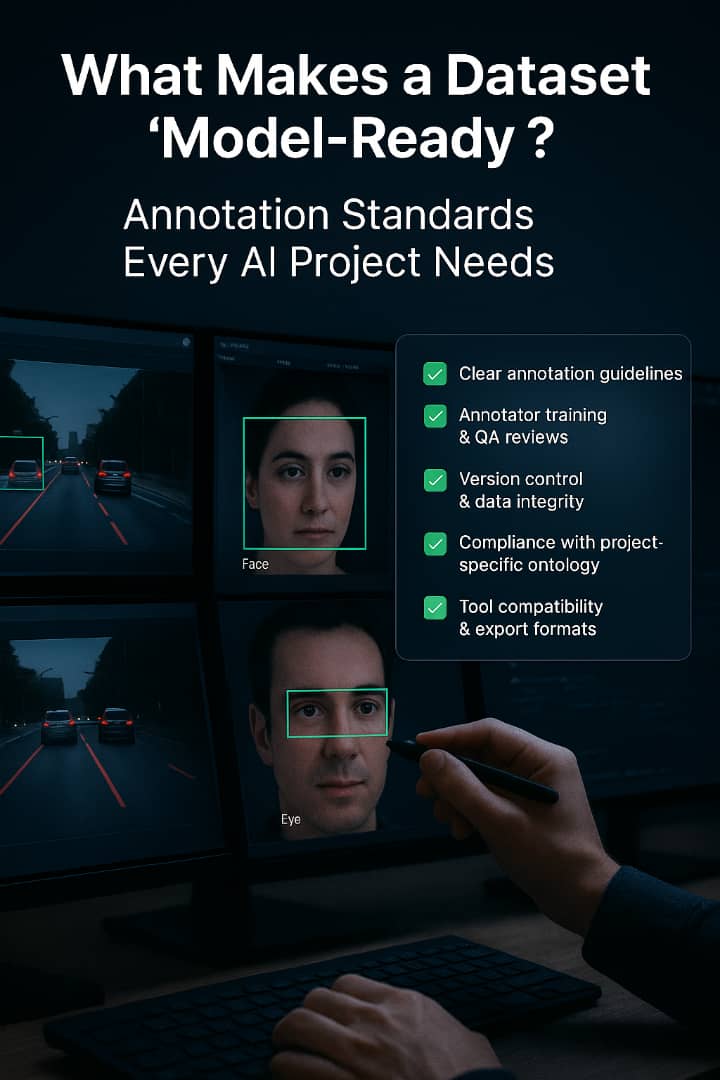Ikeja, Lagos, Nigeria

In the ever-evolving landscape of artificial intelligence (AI), much attention is given to innovative model architectures, cutting-edge algorithms, and the power of compute. However, beneath the surface of every high-performing AI system lies a foundational component that often goes unrecognised: high-quality, well-annotated, model-ready data.
Without it, even the most advanced models will underperform or, worse, fail.
Whether you’re building a next-generation computer vision system, developing a recommendation engine, or fine-tuning a large language model, the quality of your dataset is just as critical as your model architecture. Many industry experts would argue it’s more important.
In this post, we’ll walk through what it truly means for a dataset to be model-ready, why it matters more than most realise, and the key annotation standards that define model-readiness.
What Does “Model-Ready” Actually Mean?
At its core, a model-ready dataset meets rigorous standards for technical compatibility, annotation quality, and structural integrity. It’s not simply a dataset with labels; it’s a dataset that is:
- Consistently annotated across all instances
- Free from duplication, corruption, or missing entries
- Structured to integrate seamlessly into machine learning pipelines
- Aligned with the ontology, use case, and performance metrics of the model
- Version-controlled and fully documented for reproducibility
This kind of dataset minimises the overhead associated with preprocessing and allows machine learning engineers to focus on model performance, not data debugging.
Why Model-Ready Data Is a Strategic Advantage
In real-world applications, poor data quality is one of the leading causes of project failure. While model design can be iteratively improved over time, data quality issues tend to propagate silently until they show up in the form of poor predictions, bias, or deployment failures.
Key Risks of Using Poor-Quality Data:
- Reduced model accuracy
- Overfitting or underfitting
- Hidden bias
- Operational inefficiencies
According to Cognilytica’s AI and ML Lifecycle Report, up to 80% of AI project time is spent on data-related tasks, with annotation forming the bulk of that effort. Delays, mislabeling, or ambiguity can translate directly into missed deadlines, cost overruns, and performance bottlenecks.
By contrast, investing in model-ready data from the outset ensures faster iterations, lower training costs, and dramatically improved outcomes in production.
The 5 Key Annotation Standards for Model-Readiness
To build datasets that power high-performance models, annotation workflows must follow clearly defined standards. These standards ensure not only accuracy but also reproducibility, consistency, and transparency.
1. Annotation Consistency
Labels must be applied uniformly across the entire dataset. For example, a vehicle should always be tagged as “car”, not sometimes as “car” and other times as “vehicle”, “automobile”, or “sedan”.
Avoid label drift, a common error where definitions change subtly over time or across annotators.
Best Practice: Use centralised guidelines and inter-annotator agreement (IAA) metrics to detect inconsistency early.
2. Well-Defined Ontology
Your annotation ontology, the taxonomy of classes and relationships, must be clear, comprehensive, and documented. Every label should have a definition, context, and examples.
Why it matters: Without a standardised ontology, annotators will make subjective choices, leading to ambiguous data and unreliable model behaviour.
Best Practice: Create visual guides and decision trees to clarify edge cases and class boundaries.
3. Edge Case Handling
Edge cases: Blurred images, overlapping objects, distorted audio, and ambiguous text can derail a model if not handled properly. Annotators must be trained on how to label these scenarios consistently.
Inconsistent treatment of edge cases introduces noise, which reduces model robustness.
Best Practice: Maintain an “edge-case playbook” and run periodic calibration tests with your annotation team.
4. Quality Control (QC) Mechanisms
Manual review, cross-validation, random audits, and consensus checks are critical to detecting and fixing errors. Quality metrics like precision, recall, and inter-annotator agreement should be regularly monitored.
Best Practice: Establish a QC workflow with thresholds (e.g., 95%+ + agreement) and enforce rework when benchmarks are not met.
5. Metadata and Versioning
Each data point should be traceable with metadata such as:
- Annotator ID
- Annotation date
- Data source
- Annotation version
This enables teams to debug models, trace errors, and audit the data lineage effectively.
Best Practice: Use platforms that support dataset versioning, such as Labelbox, CVAT, or custom annotation pipelines integrated with Git-like version control.
How BHI Delivers Enterprise-Grade, Model-Ready Data
At Beyond Human Intelligence (BHI), we understand that great models start with great data. That’s why our annotation services are purpose-built to deliver production-grade, model-ready datasets for a wide range of industries and use cases.
Our Capabilities Include:
- Multi-format Annotation: Text, image, video, and audio
- Trained Human Annotators: Specialists with domain knowledge and ongoing calibration
- Professional Tools: CVAT, Labelbox, Audio Pro, LabelMe, and customised spreadsheets
- Automated and Manual QA: Layered quality control pipelines for error detection
- Documentation Support: Ontology design, edge case management, and version tracking
Whether you’re launching a healthcare diagnostic tool, training autonomous vehicles, or labelling conversations for a chatbot, BHI provides the structure, precision, and accountability your model needs to thrive.
Final Thoughts: Annotation Is the Foundation of Every AI Project
Data annotation is not a checkbox in your ML pipeline; it is the foundation. Models trained on inconsistent, noisy, or incomplete data will reflect those weaknesses in every decision they make.
With the stakes higher than ever, businesses must rethink their data strategies. Investing in annotation upfront is not a cost; it’s an accelerator. It improves model accuracy, reduces technical debt, and drives real-world performance.
Ready to Build Smarter, Cleaner AI Models?
Let Beyond Human Intelligence provide your team with model-ready datasets you can count on. Contact us today for a free consultation, or request a sample of our annotation work to see the BHI standard in action.
Visit our website: https://beyondhumanintelligence.com
